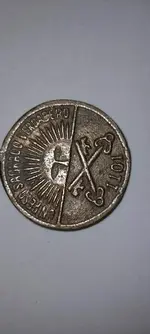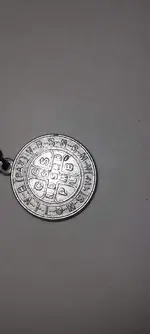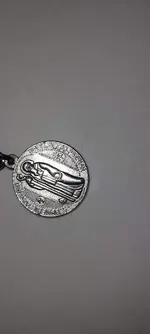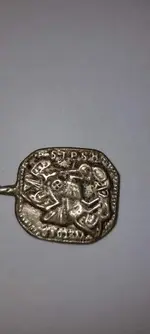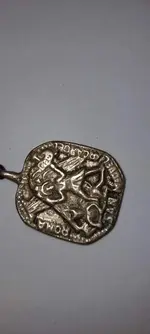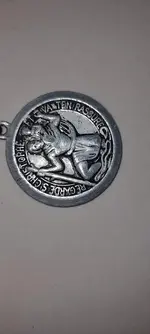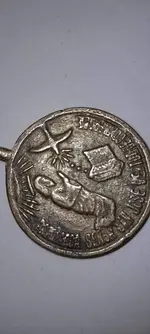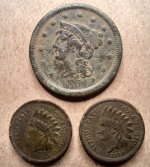You are using an out of date browser. It may not display this or other websites correctly.
You should upgrade or use an alternative browser.
You should upgrade or use an alternative browser.
I found some old medals ..
- Thread starter JJnl
- Start date
crashbandicoot
Gold Member
I don,t know what they are,but very interesting.Welcome to the site!I found some old medals
And I really have no clue what they are or if they are worth anything
Red-Coat
Gold Member
Welcome to Tnet
‘Medals’ isn’t really the right term for these. Perhaps ‘medallions’ would be appropriate but they’re charms and talismans for religious devotion or protection. Two of them have other significances.
Pics #1 and #7 are presumably the two sides of one medallion. It’s based on something called “Un Peso Sagrado Verdadero” (a true sacred Peso) with the image of St Joseph and the crossed keys. The ‘1101’ is a fictional date. Originally, these were made by modifying or carving old Spanish colonial silver coins as religious amulets, and particularly for a Filipino ‘religious’ sect (more akin to magic and sorcery) generally referred to as ‘anting-anting’ (literally meaning ‘charm’ or ‘amulet’). Sect members believed the charms to offer protection against disease, danger and death. In later times the medallions were purpose made from scratch and generally used as good luck amulets, especially by travellers.
Those later ones are generally made from base metals (often brass) and aren’t worth more than a few dollars. A bit more if made from silver. Early ones carved from old coins have rather more collector interest. Multiple examples here:
https://coinquest.com/cgi-bin/cq/coins.pl?coin=10272
Pics #2 and #3 are presumably the two sides of a St Benedict (of Nursia) medallion. The legend in full would read: EIUS IN ORBITU NOSTRO PRESENTIA MUNIAMUR (we could be protected in the moment of our death).
The other side has the Benedictine supplications: CSPB (Crux Sancti Patris Benedicti, the cross of the holy Father); CSSML (Crux Sacra Sit Mihi Lux, the holy cross will be my light); NDSMD (Non Drago Sit Mihi Lux, the devil will not be my guide) and the legend V.R.S.N.S.M.V.-- S.M.Q.L.I.V.B. In full, the Latin would be Vade Retro Satana (Begone Satan) Nunquam Suade Mihi Vana (Never Suggest Vain Things to Me), Sunt Mala Quae Libas (What You Offer Me is Evil) Ipse Venena Bibas (Drink your own Poison), interrupted by the Benedictine motto PAX (Peace).
Saint Benedict is venerated mainly by Catholics, associated with a long list of protective powers against various ailments and against evil in general (some of which derives from him surviving multiple attempts to poison him). He’s also the patron saint of Europe. Wiki page here:
https://en.wikipedia.org/wiki/Benedict_of_Nursia
Again, not much value, beyond the metal content if it happens to be silver.
Pics #4 and #5 are presumably the two sides of a San Miguel Archangel medallion. As well as having Catholic veneration, this also has a linkage to the Philippines and the ‘anting-anting’ sect. Originally, sect members believed that such amulets provided protection against weaponry and bullets in battle.
In Catholic tradition, San Miguel (St Michael) is the defender of the Church, chief opponent of Satan, and assists people at the hour of death. He’s often depicted with wings, defeating the devil portrayed as a dragon and with a ‘ROMA’ inscription, Rome being the seat of the Catholic religion.
Wiki page here:
https://en.wikipedia.org/wiki/Michael_(archangel)
Yours looks like it might have a bit of age to it and perhaps some modest value… a bit more if it’s silver.
Pic #6 is a fairly standard St Christopher medallion, favoured for protection by travellers. Yours has the legend in French "Regarde St Christophe et va-t-en rassuré” (literally “Look at/to St Christopher and go on reassured”). I don't think it's particularly old and would only have metal value if silver.
‘Medals’ isn’t really the right term for these. Perhaps ‘medallions’ would be appropriate but they’re charms and talismans for religious devotion or protection. Two of them have other significances.
Pics #1 and #7 are presumably the two sides of one medallion. It’s based on something called “Un Peso Sagrado Verdadero” (a true sacred Peso) with the image of St Joseph and the crossed keys. The ‘1101’ is a fictional date. Originally, these were made by modifying or carving old Spanish colonial silver coins as religious amulets, and particularly for a Filipino ‘religious’ sect (more akin to magic and sorcery) generally referred to as ‘anting-anting’ (literally meaning ‘charm’ or ‘amulet’). Sect members believed the charms to offer protection against disease, danger and death. In later times the medallions were purpose made from scratch and generally used as good luck amulets, especially by travellers.
Those later ones are generally made from base metals (often brass) and aren’t worth more than a few dollars. A bit more if made from silver. Early ones carved from old coins have rather more collector interest. Multiple examples here:
https://coinquest.com/cgi-bin/cq/coins.pl?coin=10272
Pics #2 and #3 are presumably the two sides of a St Benedict (of Nursia) medallion. The legend in full would read: EIUS IN ORBITU NOSTRO PRESENTIA MUNIAMUR (we could be protected in the moment of our death).
The other side has the Benedictine supplications: CSPB (Crux Sancti Patris Benedicti, the cross of the holy Father); CSSML (Crux Sacra Sit Mihi Lux, the holy cross will be my light); NDSMD (Non Drago Sit Mihi Lux, the devil will not be my guide) and the legend V.R.S.N.S.M.V.-- S.M.Q.L.I.V.B. In full, the Latin would be Vade Retro Satana (Begone Satan) Nunquam Suade Mihi Vana (Never Suggest Vain Things to Me), Sunt Mala Quae Libas (What You Offer Me is Evil) Ipse Venena Bibas (Drink your own Poison), interrupted by the Benedictine motto PAX (Peace).
Saint Benedict is venerated mainly by Catholics, associated with a long list of protective powers against various ailments and against evil in general (some of which derives from him surviving multiple attempts to poison him). He’s also the patron saint of Europe. Wiki page here:
https://en.wikipedia.org/wiki/Benedict_of_Nursia
Again, not much value, beyond the metal content if it happens to be silver.
Pics #4 and #5 are presumably the two sides of a San Miguel Archangel medallion. As well as having Catholic veneration, this also has a linkage to the Philippines and the ‘anting-anting’ sect. Originally, sect members believed that such amulets provided protection against weaponry and bullets in battle.
In Catholic tradition, San Miguel (St Michael) is the defender of the Church, chief opponent of Satan, and assists people at the hour of death. He’s often depicted with wings, defeating the devil portrayed as a dragon and with a ‘ROMA’ inscription, Rome being the seat of the Catholic religion.
Wiki page here:
https://en.wikipedia.org/wiki/Michael_(archangel)
Yours looks like it might have a bit of age to it and perhaps some modest value… a bit more if it’s silver.
Pic #6 is a fairly standard St Christopher medallion, favoured for protection by travellers. Yours has the legend in French "Regarde St Christophe et va-t-en rassuré” (literally “Look at/to St Christopher and go on reassured”). I don't think it's particularly old and would only have metal value if silver.
Last edited:
JJnl
Newbie
- Thread starter
- #7
Thank you for the explanation and descriptions of these items even the silver value is not worth much , maybe some collectors have interestWelcome to Tnet
‘Medals’ isn’t really the right term for these. Perhaps ‘medallions’ would be appropriate but they’re charms and talismans for religious devotion or protection. Two of them have other significances.
Pics #1 and #7 are presumably the two sides of one medallion. It’s based on something called “Un Peso Sagrado Verdadero” (a true sacred Peso) with the image of St Joseph and the crossed keys. The ‘1101’ is a fictional date. Originally, these were made by modifying or carving old Spanish colonial silver coins as religious amulets, and particularly for a Filipino ‘religious’ sect (more akin to magic and sorcery) generally referred to as ‘anting-anting’ (literally meaning ‘charm’ or ‘amulet’). Sect members believed the charms to offer protection against disease, danger and death. In later times the medallions were purpose made from scratch and generally used as good luck amulets, especially by travellers.
Those later ones are generally made from base metals (often brass) and aren’t worth more than a few dollars. A bit more if made from silver. Early ones carved from old coins have rather more collector interest. Multiple examples here:
https://coinquest.com/cgi-bin/cq/coins.pl?coin=10272
Pics #2 and #3 are presumably the two sides of a St Benedict (of Nursia) medallion. The legend in full would read: EIUS IN ORBITU NOSTRO PRESENTIA MUNIAMUR (we could be protected in the moment of our death).
The other side has the Benedictine supplications: CSPB (Crux Sancti Patris Benedicti, the cross of the holy Father); CSSML (Crux Sacra Sit Mihi Lux, the holy cross will be my light); NDSMD (Non Drago Sit Mihi Lux, the devil will not be my guide) and the legend V.R.S.N.S.M.V.-- S.M.Q.L.I.V.B. In full, the Latin would be Vade Retro Satana (Begone Satan) Nunquam Suade Mihi Vana (Never Suggest Vain Things to Me), Sunt Mala Quae Libas (What You Offer Me is Evil) Ipse Venena Bibas (Drink your own Poison), interrupted by the Benedictine motto PAX (Peace).
Saint Benedict is venerated mainly by Catholics, associated with a long list of protective powers against various ailments and against evil in general (some of which derives from him surviving multiple attempts to poison him). He’s also the patron saint of Europe. Wiki page here:
https://en.wikipedia.org/wiki/Benedict_of_Nursia
Again, not much value, beyond the metal content if it happens to be silver.
Pics #4 and #5 are presumably the two sides of a San Miguel Archangel medallion. As well as having Catholic veneration, this also has a linkage to the Philippines and the ‘anting-anting’ sect. Originally, sect members believed that such amulets provided protection against weaponry and bullets in battle.
In Catholic tradition, San Miguel (St Michael) is the defender of the Church, chief opponent of Satan, and assists people at the hour of death. He’s often depicted with wings, defeating the devil portrayed as a dragon and with a ‘ROMA’ inscription, Rome being the seat of the Catholic religion.
Wiki page here:
https://en.wikipedia.org/wiki/Michael_(archangel)
Yours looks like it might have a bit of age to it and perhaps some modest value… a bit more if it’s silver.
Pic #6 is a fairly standard St Christopher medallion, favoured for protection by travellers. Yours has the legend in French "Regarde St Christophe et va-t-en rassuré” (literally “Look at/to St Christopher and go on reassured”). I don't think it's particularly old and would only have metal value if silver.
Top Member Reactions
-
 2574
2574 -
 1140
1140 -
 1051
1051 -
 910
910 -
 889
889 -
 833
833 -
 815
815 -
 704
704 -
 641
641 -
 527
527 -
 496
496 -
 495
495 -
 486
486 -
 464
464 -
 462
462 -
O
442
-
 422
422 -
 396
396 -
 377
377 -
 364
364
Users who are viewing this thread
Total: 2 (members: 0, guests: 2)


